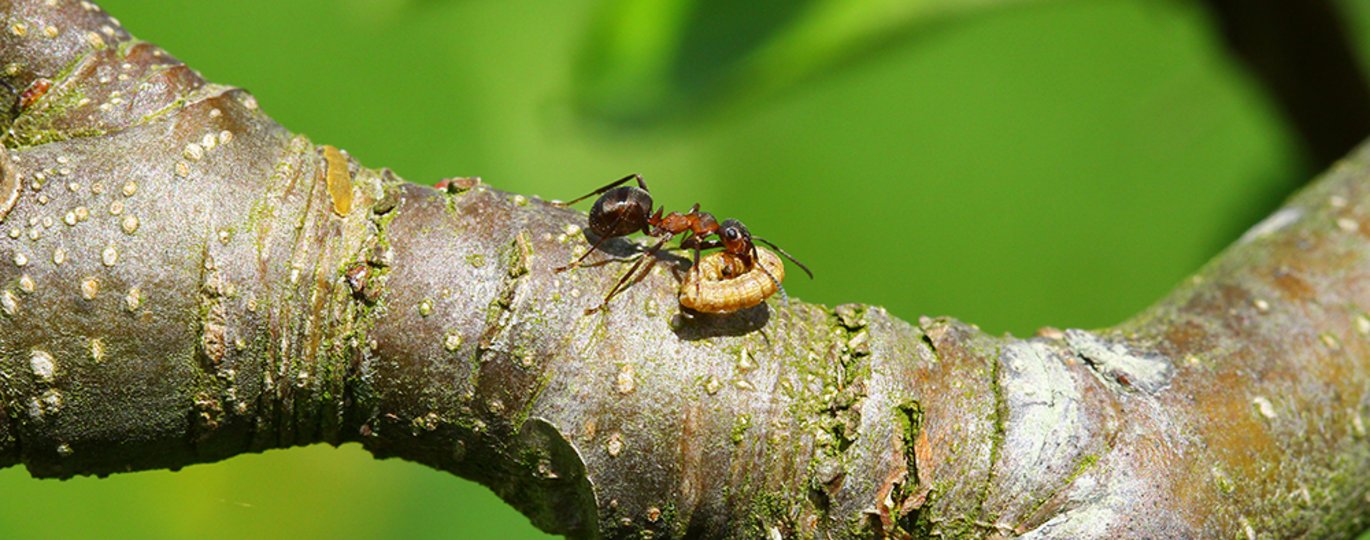Wood ants as crop protection in Danish orchards
It is easy to transplant wood ants into apple orchards. When doing so, the ants adapt to their new surroundings and begin to eat the pests on the trees.

In a project at an apple orchard in Djursland, Denmark, we saw that wood ants quickly established themselves in the orchard, and they have now survived for two summers. Among other things, we observed that wood ants prey on winter moth larvae, which previously have defoliated parts of the orchard. This may be the reason why we measured twice the yield in apple trees with ants - compared to neighboring trees without ants (excluding ants with a glue barrier).
However, it should be noted that the apple harvest in 2015 was very poor and that the yield from 2016 has not yet been analyzed. Other results from the project indicate that the ants may possibly reduce apple rot disease (monilinia) and enrich trees with the nutrient magnesium, but ants may also cause an increased number of green apple aphids (Aphis pomi).
Expected wide use
MothStop is a pilot project and not all data have been analyzed yet, so follow-up studies are required. But, based on the current information, indications are that wood ants may become a new viable tool in pest control in organic orchards, not only in the case of apples, but also when it comes to other types of fruit and e.g. in berries and Christmas trees. We know that ants are able to thrive in Christmas tree farms and, thus, most probably in most types of plantations. We also know that wood ants prey on many different types of pests.
Ants and aphids
The positive effects of ants on aphids need to be studied further in order to prevent that solving one problem may lead to a new.
Ants protect the aphids in order to get access to the sugary honeydew they secrete. It is expected that by sugar-feeding ants, they will lose interest in the aphids and may even prey on them. Such behavioral changes have been observed in other ants, and companies in the plant conservation industry have therefore started to develop sugar mixtures that can spoil the collaboration between ants and aphids. The key is to find sugar mixtures containing the correct amount of sugar and other attractive substances (e.g. amino acids) so that the mixture becomes more attractive than the honeydew produced by the aphids.
Prospects for organic production, consumers and society
For the organic production of fruit, berries and Christmas trees, the use of wood ants may prove to be a welcome new tool for pest control, when other approved methods fail. Ants may be used temporarily (they are easy to remove again) during a pest outbreak or can be used on a permanent basis to prevent such outbreaks.
This will ensure more stable yields for organic farmers and, thus, increase their competitiveness against conventional farming. For consumers, this may lead to a larger supply of organic fruits, berries and Christmas trees, which currently are in short supply. For society, it means lower environmental contamination with pesticides from conventional farming and an increased credibility for organic farming.
Visit the project website of MothStop
The project MothStop is part of the Organic RDD 2.2 program, coordinated by ICROFS (International Centre for Research in Organic Food Systems). It has received grants from the Green Development and Demonstration Programme (GUDP) under the Environment and Food Ministry.